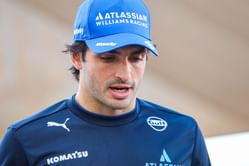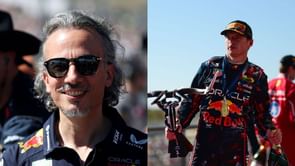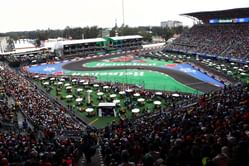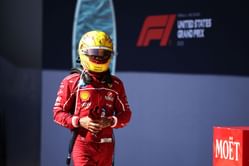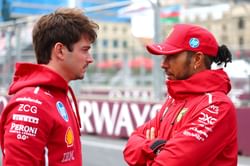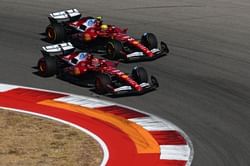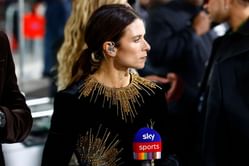The modern F1 cars are one among the most technologically advance machines the sport is ever witnessed. Every adjustment a driver might need to do while driving at speeds of 300 Kmph or more, every bit of information he might need to know, is quite literally at his fingertips. So, how do they do that? Let’s take an in-depth look into a modern F1 steering wheel and how it works?
The F1 Steering wheel is not only used to steer the car but also acts an on-board controller and diagnosis unit. Lets consider the steering wheel used on the Mercedes AMG Petronas F1 car as the reference. Different F1 teams have their own layout and the settings may vary but they are all very similar. Also, the steering wheel layout may be differ from driver to driver as they are custom made as per driver preferences.
The F1 Steering Wheel
![]()
DISPLAY:
The F1 cars use an OLED display screen which can display up to 100 pages of information. The drivers have access to various data such as their speed,lap time, difference to the leader,Battery energy status, Tyre pressure etc. All of this vital information can be displayed in a color screen and thus makes it easy for the driver to know the status of the car. Also, the team can notify the driver via the screen immediately if something is critical.
LIGHTS:
Above the OLED display there is the gear shift lights indicating the Rev-Limter or the Red Line which helps he driver in optimising the gear shifts.The 2 pairs of lights (Yellow and white) indicate a Yellow flag and danger zone respectively.
Mercedes Driver Valtteri Bottas explains the working of the 2019 F1 Steering Wheel.
BUTTONS:
N(neutral)Button
The gear shift levers which are mounted at the back cannot engage reverse and neutral gears. So, there’s a dedicated button for this purpose. Both, neutral and reverse can be engaged by the “N” button, by either just one press or a long press.
DRS (Drag Reduction System) Button:
Pressing this button in the pre designated DRS zone opens the DRS flap present on the rear wing thus reducing drag on the straights and helps in achieving better straight line speeds.
X Button:
The confirm button which is used to acknowledge any instruction coming from the pit wall.
OT(Overtake) Button:
Pressing the overtake button gives maximum boost from the engine and the ERS system which increases the BHP during the period of time.
PC(Pit-Confirm) Button:
The driver instructs the pit crew and the team that he is about to enter the pits by pressing PC button thus allowing the pit crew to be ready with the tyres.
PL Button:
The Pit-lane speed limiter button is used to limit the speed of the car to the designated pit-lane speed limit of 60 Kmph in the pit lane.
Talk Button:
This is used by the driver to communicate via the radio to the pit wall.
RS(Race Start) Button:
The RS button is used during the start of the race, pressing it accesses a pre-set launch map which includes optimal clutch bite and ERS settings thereby helping in preventing the wheel spin during the launch.
Mark Button:
This is used to identify a point of interest in the data as indicated by the driver.
ROTARY THUMB DIALS:
There are 6 rotary thumb dials which allows the driver to change the settings with just the usage of his thumb while the hand stays on the steering wheel
ENTRY and EXIT Thumb Dial:
The entry and exit rotaries are used to adjust the differential settings while entering a corner and exiting. The differential regulates the speed of the wheel of one side in respect to the wheel on other side. Say the driver is taking a left turn so the wheel on the left has to cover lesser distance than the wheel on the right to negotiate the turn.So, in order to prevent the dragging of the tyres the differential instructs the right wheel to be rotated at a higher speed compared to the left. This setting is very important to get optimum balance.
MID and HI SPEED Thumb dial:
The Mid and Hi-speed dials also adjust the differential. One is for mid-corner while other is for Hi-speed corners.
Brake Balance thumb dial:
This is denoted as BB+ and BMIG. These are extensions of the mechanically operated brake bias lever which is present inside the cockpit.Using these dials the driver can set the brake bias either to the front or back depending on his preference.
With the introduction of ERS system, adjusting brake balance has become so critical,the braking action is done by mechanically operated brakes plus the MGU-K(Regenerative braking). And, so there’s the usage of term “Brake-by-wire”.
The computer splits the front and rear brake bias according to the energy harvest settings while achieving the optimum brake balance has become much tougher. Now, the driver has to adjust brake balance in conjunction with energy harvest and boost settings to find the optimum performance.
ROTARY DIALS:
There are 3 rotary dials, which is in the bottom of the steering wheel.
STRAT(Left Rotary):
Strat in short means the strategy dial and it is mainly used to control ERS (energy recovery system) harvest and boost settings, through this dial the driver can adjust the balance between energy recovery and energy boost, so say at the start of the race you will usually see drivers in mode “STRAT3” in which there is preference to the boost side of the settings. So, the amount of harvest will be less compared to the boost supplied.
Multi-Function Rotary(Centre Rotary):
The dial is used to control an array of settings such as BITE (to find the clutch bite point ), TRQ (torque), BBW (Brake-By-Wire) and TYRE.
HPP(High Powertrain Rotary-Right Dial):
This is used to control engine settings i.e of the V6 Internal combustion engine or the power unit by using different modes indicated by the number, the air-fuel mixtures and ignition timings can be adjusted. So, say a driver is engaged in a battle with another car, so he wants maximum power, the driver will adjust settings such that rich fuel mixture (More Fuel and Less Air) is supplied to the engine thus giving him more power.
